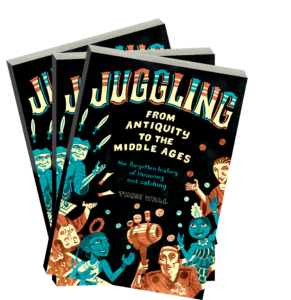The Midwest Book Review
A review of “Juggling – From Antiquity to the Middle Ages: the forgotten history of throwing and catching”.
Anybody who’s ever wanted to throw a ball and juggle anything in life will welcome the rare opportunity to learn about its evolution in Juggling – From Antiquity to the Middle Ages: The Forgotten History of Catching and Throwing.
Readers who might think juggling holds a singular Western history will be surprised to learn that it actually was discovered in several cultures, all isolated from one another, and can be documented as early as 2,000 BCE.
Thom Wall opens with a pointed observation about why documenting the history of juggling is so difficult to pinpoint: “As with dance, so with juggling—the moment that the performer finishes the routine, their act ceases to exist beyond the memory of the audience. There is no permanent record of what transpired, so studying the ancient roots of juggling is fraught with difficulty.”
The chronicles that follow are arranged chronologically, from ancient writings, relics, and indicators of juggling to modern times. Good-sized color images of relics and writings often accompany footnoted research documenting juggling’s evolutionary process, providing readers with both a visual and text record of its appearance in art forms, history, social interactions, and human society.
It should be noted that Juggling doesn’t just assemble historical evidence. Wall discusses the quality of the evidence itself and the extrapolations that can be made from it: “Though this passage doesn’t describe a literal performance, it does serve as evidence that jugglers were performing with swords and on tightropes in present-day Turkey as early as the 4th and 5th centuries.”
This approach lends an authoritative, critical thinking perspective supplementing the historical examination, offering readers more than just clues to juggling’s appearance and performances over the centuries. Readers actually learn how to analyze and assess data and draw conclusions from a survey that is dedicated to exploring all aspects of juggling, from its social and sports impact to its legal ramifications: “The jongleur’s performances in early medieval Ireland were regulated by the law—or at least there were rules set forth for the compensation of audience members accidentally injured by jugglers during performances.”
Readers will find juggling’s story broader than anticipated, crossing disciplines with a deft attention to detail that follows juggling’s influence on not just societies and cultures, but gender roles: “Anthropologist Avigail Morris, who spent considerable time studying gender roles in traditional Tongan society, asserts that hiko exemplified the feminine ideal in Tonga and that “the motions and gestures used in the game bring out beauty and gracefulness in females of all ages”—in particular, the flexible and graceful motions of the wrists.” Morris explains that hiko’s mystical origins align it with “traditional concepts of beauty and sexuality” and allow a girl to “show off just how feminine she could be” (Morris, 2009).”
This history requires of its readers some prior affinity and affection for juggling; but richly rewards a reader’s basic interest. What seems like (and is) a complex, scholarly approach to the subject takes on a lively feel through embellishments and discussions that successfully relate juggling skills and approaches to wider examinations of social organization, skills development, and cultural evolution.
Jugglers especially (but general-interest audiences, as well) will appreciate the surprising accessibility and depth in Juggling – From Antiquity to the Middle Ages: The Forgotten History of Catching and Throwing, a primer packed with unexpected insights and an exquisitely involving attention to detail.
– D. Donovan, Senior Reviewer, Midwest Book Review
Be the first to know when the book is available!
About the Midwest Book Review:
Started in 1976, The Midwest Book Review is an online monthly publication aimed at librarians, booksellers, as well as the general reading public. Its mission is to promote literacy, library usage, and small press publishing, which is why this publication is so popular among small publishers, self-published authors, and academic presses.




